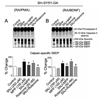SNJ-1945, a calpain inhibitor, protects SH-SY5Y cells against MPP(+) and rotenone
- PMID: 24341912
- PMCID: PMC4038676
- DOI: 10.1111/jnc.12629
SNJ-1945, a calpain inhibitor, protects SH-SY5Y cells against MPP(+) and rotenone
Abstract
Complex pathophysiology of Parkinson's disease involves multiple CNS cell types. Degeneration in spinal cord neurons alongside brain has been shown to be involved in Parkinson's disease and evidenced in experimental parkinsonism. However, the mechanisms of these degenerative pathways are not well understood. To unravel these mechanisms SH-SY5Y neuroblastoma cells were differentiated into dopaminergic and cholinergic phenotypes, respectively, and used as cell culture model following exposure to two parkinsonian neurotoxicants MPP(+) and rotenone. SNJ-1945, a cell-permeable calpain inhibitor was tested for its neuroprotective efficacy. MPP(+) and rotenone dose-dependently elevated the levels of intracellular free Ca(2+) and induced a concomitant rise in the levels of active calpain. SNJ-1945 pre-treatment significantly protected cell viability and preserved cellular morphology following MPP(+) and rotenone exposure. The neurotoxicants elevated the levels of reactive oxygen species more profoundly in SH-SY5Y cells differentiated into dopaminergic phenotype, and this effect could be attenuated with SNJ-1945 pre-treatment. In contrast, significant levels of inflammatory mediators cyclooxygenase-2 (Cox-2 and cleaved p10 fragment of caspase-1) were up-regulated in the cholinergic phenotype, which could be dose-dependently attenuated by the calpain inhibitor. Overall, SNJ-1945 was efficacious against MPP(+) or rotenone-induced reactive oxygen species generation, inflammatory mediators, and proteolysis. A post-treatment regimen of SNJ-1945 was also examined in cells and partial protection was attained with calpain inhibitor administration 1-3 h after exposure to MPP(+) or rotenone. Taken together, these results indicate that calpain inhibition is a valid target for protection against parkinsonian neurotoxicants, and SNJ-1945 is an efficacious calpain inhibitor in this context. SH-SY5Y cells, differentiated as dopaminergic (TH positive) and cholinergic (ChAT positive), were used as in vitro models for Parkinson's disease. MPP+ and rotenone induced up-regulation of calpain, expression, and activity as a common mechanism of neurodegeneration. SNJ-1945, a novel calpain inhibitor, protected both the cell phenotypes against MPP+ and rotenone.
Keywords: calpain; cell viability; experimental parkinsonism; inflammation; neuroprotection; oxidative stress.
© 2013 International Society for Neurochemistry.
Conflict of interest statement
The authors have no conflicts of interest to declare.
Figures









Similar articles
-
Calpain inhibition protected spinal cord motoneurons against 1-methyl-4-phenylpyridinium ion and rotenone.Neuroscience. 2011 Sep 29;192:263-74. doi: 10.1016/j.neuroscience.2011.06.007. Epub 2011 Jun 22. Neuroscience. 2011. PMID: 21723922 Free PMC article.
-
D-beta-hydroxybutyrate protects dopaminergic SH-SY5Y cells in a rotenone model of Parkinson's disease.J Neurosci Res. 2006 Nov 1;84(6):1376-84. doi: 10.1002/jnr.21021. J Neurosci Res. 2006. PMID: 16917840
-
Extranigral neurodegeneration in Parkinson's disease.Ann N Y Acad Sci. 2008 Oct;1139:331-6. doi: 10.1196/annals.1432.002. Ann N Y Acad Sci. 2008. PMID: 18991878
-
Chrysotoxine, a novel bibenzyl compound selectively antagonizes MPP⁺, but not rotenone, neurotoxicity in dopaminergic SH-SY5Y cells.Neurosci Lett. 2012 Jul 11;521(1):76-81. doi: 10.1016/j.neulet.2012.05.063. Epub 2012 Jun 1. Neurosci Lett. 2012. PMID: 22659498
-
Effects of a novel orally administered calpain inhibitor SNJ-1945 on immunomodulation and neurodegeneration in a murine model of multiple sclerosis.J Neurochem. 2014 Jul;130(2):268-79. doi: 10.1111/jnc.12659. Epub 2014 Feb 12. J Neurochem. 2014. PMID: 24447070 Free PMC article.
Cited by
-
Neurotoxin mechanisms and processes relevant to Parkinson's disease: an update.Neurotox Res. 2015 Apr;27(3):328-54. doi: 10.1007/s12640-015-9519-y. Epub 2015 Jan 29. Neurotox Res. 2015. PMID: 25631236
-
Zhenbao pill protects against acute spinal cord injury via miR-146a-5p regulating the expression of GPR17.Biosci Rep. 2018 Jan 19;38(1):BSR20171132. doi: 10.1042/BSR20171132. Print 2018 Feb 28. Biosci Rep. 2018. PMID: 29187582 Free PMC article.
-
Calpain inhibition as a possible new therapeutic target in multiple sclerosis.AIMS Mol Sci. 2017;4(4):446-462. doi: 10.3934/molsci.2017.4.446. Epub 2017 Oct 26. AIMS Mol Sci. 2017. PMID: 40181912 Free PMC article.
-
Chronic intermittent ethanol induced axon and myelin degeneration is attenuated by calpain inhibition.Brain Res. 2015 Oct 5;1622:7-21. doi: 10.1016/j.brainres.2015.06.014. Epub 2015 Jun 20. Brain Res. 2015. PMID: 26100335 Free PMC article.
-
The SH-SY5Y cell line in Parkinson's disease research: a systematic review.Mol Neurodegener. 2017 Jan 24;12(1):10. doi: 10.1186/s13024-017-0149-0. Mol Neurodegener. 2017. PMID: 28118852 Free PMC article.
References
-
- Bains M, Cebak JE, Gilmer LK, Barnes CC, Thompson SN, Geddes JW, Hall ED. Pharmacological analysis of the cortical neuronal cytoskeletal protective efficacy of the calpain inhibitor SNJ-1945 in a mouse traumatic brain injury model. J Neurochem. 2013;125:125–132. - PubMed
-
- Banik NL, Hogan EL, Jenkins MG, McDonald JK, McAlhaney WW, Sostek MB. Purification of a calcium-activated neutral proteinase from bovine brain. Neurochem Res. 1983;8:1389–1405. - PubMed
-
- Braak H, Sastre M, Bohl JR, de Vos RA, Del Tredici K. Parkinson's disease: lesions in dorsal horn layer I, involvement of parasympathetic and sympathetic pre- and postganglionic neurons. Acta Neuropathol. 2007;113:421–429. - PubMed
-
- Cheng YF, Zhu GQ, Wang M, et al. Involvement of ubiquitin proteasome system in protective mechanisms of Puerarin to MPP(+)-elicited apoptosis. Neurosci Res. 2009;63:52–58. - PubMed
Publication types
MeSH terms
Substances
Grants and funding
LinkOut - more resources
Full Text Sources
Other Literature Sources
Research Materials
Miscellaneous

